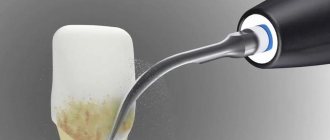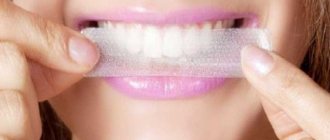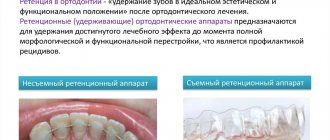The teeth whitening procedure allows you to return the enamel to its original color and make your smile as aesthetically pleasing as possible. However, you need to remember that you cannot limit yourself to the procedure in the dentist’s office - in the first time after it is carried out (about 5-10 days), it is important for the patient to maintain and consolidate the achieved result. Restoring teeth after whitening and preserving the resulting enamel color is the patient’s main concern during this period.
Why do teeth darken after whitening?
The following factors influence the change in color and tone of tooth enamel after the procedure:
- external staining (in fact, it is a colored plaque on the teeth);
- penetration of coloring substances deep into the enamel through existing microspaces;
- smoking;
- taking certain medications (for example, iron supplements) or rinsing the mouth with coloring solutions (for example, hydrogen peroxide);
- poor oral hygiene [1].
Why do you need to eat this kind of food after the procedure?
The fact is that after the procedure the enamel becomes porous and more susceptible, including to dyes. The coloring pigment, which is found in a number of foods and drinks, easily penetrates and is absorbed into the lightened enamel.
In addition, after whitening, the enamel becomes more sensitive, so in the first few days after whitening you should avoid eating sour, hot and cold foods. You should also avoid eating too hard foods.
The most dangerous period is the first two days after the procedure. For the first 48 hours, you must strictly adhere to a white diet, and in subsequent days, consume unwanted foods in minimal quantities.
The longer the restriction from forbidden foods continues, the longer the result of the procedure will be.
Actions to maintain whitening results
After visiting the dentist's office, the work on the beauty of your smile does not end. The recommendations of the attending physician, as well as general standards of oral hygiene, should be followed.
- Brush your teeth daily with a suitable toothbrush.
- Use toothpaste without coloring ingredients.
- Choose a toothpaste that will strengthen the enamel layer and reduce sensitivity (such products contain fluoride compounds - aminofluoride, sodium fluoride or hydroxyapatite).
- Follow a “white” diet.
- Use floss to clean interdental spaces.
- Avoid decorative cosmetics for several days to avoid staining your teeth pinkish-red (lipstick, lip gloss).
The effect of teeth whitening lasts on average six months.
Everyone has a unique dentin color and enamel thickness, so the results will vary. A patient cannot be guaranteed a certain tooth color. It is important to remember that the result does not depend on the drug or the doctor, but rather on the individual characteristics of the body. Akhutina K.K., chief physician of the Allegro dental clinic (two years in a row included in the list of the 100 best private dental clinics in Russia and in the top ten best clinics in St. Petersburg according to the Kommersant Publishing House) [2]
Features such as the natural yellow or grayish tint of the enamel can be changed slightly. In this same situation, careful oral hygiene and good habits can play a decisive role and prolong the whitening effect.
How to keep your teeth white for a long time
The darker a person's skin tone, the whiter their smile appears. It is this fact that explains why the teeth of dark-skinned people appear snow-white to others. We must admit that the natural white color of the dentition is a real gift from nature. However, it is known that only 5% of the world's population have such an impeccable shade of enamel. The rest will have to work hard to get white teeth. To do this, you can use modern methods of care and whitening.
Important! Even after resorting to professional help, it is necessary to maintain the results obtained at home for as long as possible.
What is the secret to keeping your teeth white?
Natural whiteness is an integral component of organ health. To achieve this, you need to:
- promptly treat caries of the entire oral cavity;
- carry out high-quality filling;
- care for and strengthen teeth;
- polish tooth enamel, etc.
If your mouth is healthy, all that remains is to freshen your breath and give your snow-white smile a dazzling, flawless look. Fortunately, the technical equipment and professionals of Crystal Dentistry provide the highest level of service.
Tooth enamel is considered the hardest tissue in the body. It provides thorough chewing and gnawing, and when consuming food or drinks, it exhibits a certain resistance to hot or cold temperatures. However, teeth are located in the oral cavity, they are surrounded by mucous membranes, which are “populated” by millions of bacteria. Daily brushing of teeth at least 2 times a day is a salvation against an army of such “pests”.
Factors that have a detrimental effect on enamel are:
- eating sweet foods that leave plaque on the teeth;
- presence of bad habits (smoking, alcohol);
- frequent consumption of strong drinks (coffee, cocoa, tea);
- fast food abuse;
- frequent consumption of foods high in dyes and preservatives.
If the patient cares about a beautiful smile, the food consumed should be controlled, and oral care should be more thorough.
Features of daily care after whitening
Procedures can be divided into two groups:
- Cleansing teeth and root of tongue from plaque.
Studies show that within 4–6 hours after the “work” of the toothbrush, a soft layer is deposited on the surface of the tooth. If the problem is ignored, it quickly accumulates and turns into a dense coating. The color of teeth becomes dull and deteriorates, since toxins, acids, and potential causative agents of infections and inflammations released by microorganisms are considered the most likely causes of the loss of the healthy appearance of teeth. - Restoring enamel using special toothpastes.
The structure of a healthy organ is 95% composed of strong calcium and phosphorus mineral complexes. The rest is occupied by organic matter and water. In a healthy state, processes of remineralization and demineralization of enamel occur on the surface of the tooth. They are in relative balance. During remineralization, Ca penetrates from food into saliva and then saturates the structure of the surface layers of enamel. During demineralization, acids and bacteria “isolate” the mineral from the surface of the tooth, destroying it. If there is no constant care and cleaning, the latter process begins to prevail, and the tooth enamel loses its structure and changes color.
How to maintain whiteness for a long time after bleaching
It is important to remember not only the quantity, but also the quality of cleaning. Teeth care after whitening should be more thorough. Yellow, soft deposits can be easily removed by regular cleaning, choosing a brush with medium-hard bristles. The procedure should take place within 3 minutes. Dental floss should be used between rows. Don't forget about the rinse aid. If the accumulated deposits cannot be removed on your own, you can resort to professional cleaning and removal of tartar in the clinic.
After the whitening procedure, it is recommended to carry out a course of restorative measures lasting about 1 month. How to keep teeth white for a long time without good restoration? It is advisable to choose toothpaste with sufficient fluoride or calcium compounds. They help strengthen the structure of tooth enamel.
What is the “white diet”
After whitening, the doctor will definitely talk with you and give effective recommendations on how to keep your teeth white for a long time. Among these methods is eating colorless food. The “White Diet” is a list of products that, after lightening, will make up a person’s daily diet. Often, a specialist recommends sticking to it for several weeks after the whitening procedure. The list of selected products includes:
- white meat fish, stewed or baked chicken;
- potatoes, cabbage;
- White mushrooms;
- rice, soy;
- milk, fermented milk products, tofu cheese;
- green apples, pears;
- walnuts;
- wheat bread.
With this diet, the consumption of coloring “irritants” should be avoided. To maintain white teeth, you should exclude: bright vegetables, fruits, red wine, desserts, carbonated drinks, chocolate, artificial sweets, sauces, spices, smoked meats, “quick” soups.
What foods prolong the health and whiteness of teeth?
Strong enamel is the key to a beautiful smile. A proven way to keep it white and healthy is to eat healthy foods. This list includes:
- fresh solid vegetables and fruits (carrots, cabbage, broccoli, apples);
- dairy products rich in calcium (hard cheese, feta cheese, cottage cheese);
- nuts, white and black sesame;
- fresh juices (when consumed through a straw).
Don’t forget about special chewing gums without dye. It is necessary to limit the consumption of sugar-containing products to a minimum.
Products hazardous to tooth color
Some products have the ability to color surfaces upon contact, especially porous tooth enamel, due to the presence of their own pigments:
- Black tea;
- cocoa;
- coffee;
- bright sauces (soy, curry, ketchup, etc.);
- colored fruits, including citrus fruits;
- vegetable and fruit juices;
- fruit drinks and compotes;
- carbonated drinks with dyes;
- chocolate;
- berries and jam;
- egg yolks;
- alcohol (red wine).
In the first two weeks, it is especially important to adhere to strict restrictions and recommendations of the dentist. After bleaching, the micropores open and absorb dyes faster. You need to exclude colored foods from your diet at least for the first time.
Is it safe to whiten teeth?
When choosing competent specialists, carrying out the procedure in a dental clinic, using high-quality whitening systems, taking into account all the patient’s health characteristics, whitening is a safe procedure. In the future, doctors monitor patients during regular preventive examinations.
When properly selected, the whitening composition does not harm the enamel and does not affect the strength of hard dental tissues. Our center’s specialists monitor patients who have had their teeth whitened for at least 5 years. To summarize the observations, we can say that clients tolerate this procedure well and are satisfied with its results.
What is necessary for a positive prognosis after whitening? Individual selection of a modern and safe whitening system, regular preventive examinations after teeth whitening and monitoring of the condition of the oral cavity and the whole body.
Thanks to regular meetings with the patient, it is possible to diagnose this or that pathology in a timely manner, assess the condition of dental tissues, the amount of soft and hard deposits on the enamel, and assess the safety of installed fillings and crowns. This allows you to prevent the development of severe conditions that are dangerous to the patient’s health. Our doctors evaluate the quality and extend the service life of fillings and crowns installed by their colleagues from other clinics.
In some cases, you just need to polish the slightly modified filling, and it will be able to stay in the tooth for another couple of years. If minor defects are not corrected, caries may develop in the filled tooth, and the filling will need to be reinstalled in the future. Also, during preventive examinations, hygienists tell patients how best to care for their teeth in order to avoid the appearance of soft plaque and tartar, which toothpaste and brush is best to use, etc.
Teeth whitening
– a serious procedure, therefore, in the presence of severe concomitant diseases, doctors advise against performing it. Most researchers agree that in the short term, whitening does not cause serious harm to health and does not have any significant negative effect on the condition of teeth and gums. More long-term consequences of exposure to atomic oxygen and peroxide compounds included in bleaching systems require more detailed study. Therefore, a person should make a decision about the need to lighten their teeth carefully and thoughtfully after consulting a doctor and reviewing all available information.
What can you eat after teeth whitening?
The post-bleaching diet includes foods high in fluoride, calcium and phosphorus, vitamins C, A and E, and those that do not have bright colors [3, 4]:
- white meat;
- white fish;
- eggs (whites only);
- cereals (rice, pearl barley, oatmeal);
- white beans;
- soft and mild cheese;
- milk (fermented milk products are allowed only after 2-3 days, including yogurt without dyes);
- butter;
- vegetable oil;
- mushrooms with light flesh (white, champignons);
- potato;
- light vegetables (peeled cucumbers, white bell peppers);
- pasta;
- boiled or steamed cabbage;
- white or clear drinks.
Food should be warm or cool - nothing icy or scalding.
Nutrition rules after bleaching
Professional teeth whitening requires strict restrictions in the first days after the procedure. For 2–3 days you should avoid drinks and foods with coloring pigments. You can only eat food that is not brightly colored, not too sweet or sour. The following are prohibited:
- coffee Tea;
- chocolate;
- citruses;
- carbonated drinks;
- all bright vegetables and fruits, including beets, carrots, tomatoes;
- spices and herbs with a coloring effect;
- red wine;
- fermented milk products;
- sauces (mustard, ketchup, etc.).
You can return to a full diet in about a month with a gradual return of coloring foods. Caution should be exercised when eating solid foods, which can damage the enamel. It is advisable not to eat hot and then immediately cold foods, as sudden temperature fluctuations can harm your teeth.
Sample menu for the week
Smile-safe food plan for the first weeks after whitening [3]:
| Days | Breakfast | Snack | Dinner | Dinner |
| 1st and 4th | Oatmeal with milk, cottage cheese, raisins, fermented baked milk. | Yogurt, banana. | Two boiled eggs, green tea with milk, cottage cheese with sour cream. | Cookies, yogurt. |
| 2nd and 5th | Rice porridge with honey, yogurt. | Sandwiches with butter and cheese, yogurt. | Mushroom cheese soup, steamed white meat with vegetables. | Banana, yogurt. |
| 3rd and 6th | Vermicelli porridge with milk, cottage cheese. | A handful of nuts, two boiled eggs. | Noodle soup, boiled potatoes with chicken. | Ryazhenka. |
| 7th | Semolina porridge with milk and butter. | White grapes, peach, peeled apples. | Boiled or baked fish with a side dish of steamed cauliflower. | Salad of peeled cucumbers or light, non-acidic fruits. |
List of sources:
- Burak J. Why teeth darken and how to restore their whiteness, portal “Healthy People” (24health.by), 2022 // URL: https://health.tut.by/news/disease/692875.html (access date: 02.11.2020).
- 10 facts about teeth whitening. Doctor's opinion. ONDOC, 2022 // URL: https://ondoc.me/blog/posts/9 (access date: 12/01/2020).
- Bolotina T.A. White diet after teeth whitening. Blog of practicing dentists DentConsult, 2022 // URL: https://dentconsult.ru/otbelivanie-i-chistka/belaya-dieta-posle-otbelivaniya-zubov.html (date of access: 02.11.2020).
- Vovilyuk A.L. Diet after teeth whitening. Dental portal “Anatomy of teeth”, 2005 // URL: https://yandex.ru/turbo/anzub.ru/s/esteticheskaya-stomatologiya/dieta-posle-otbelivaniya-zubov/ (date of access: 02.11.2020) .
Restrictions after the procedure and terms of their observance
As a rule, after the procedure, the specialist gives the patient a leaflet indicating foods and drinks that should be avoided - the so-called white diet. In addition, the leaflet provides general recommendations that must be followed.
The transparent or white diet is a special diet that you need to follow after teeth whitening. Following such a diet will help avoid staining or darkening of lightened enamel.
First of all, the diet implies the exclusion of coloring pigment from the list of foods and drinks consumed. Already from the name of the diet it is clear that it includes light-colored foods.
Conclusion
Following the simple rules of a white diet will help you prevent the appearance of dark colors on newly bleached enamel. In order not to undergo the teeth whitening procedure frequently, and to maintain its results for as long as possible, you need to exclude prohibited foods, if possible, all the time. If you couldn’t resist eating or drinking something from the prohibited menu, you can immediately brush your teeth; of course, your toothbrush should be available at this time. Chewing gum will not help much in this case. A snow-white smile will be your reward for constantly using restrictions. Teeth whitening and dental care products can be purchased here.
What is the essence of the white diet?
It is called white not because it consists entirely of dairy products. All products that contain coloring substances that can change the color of tooth enamel are excluded from the menu. You will also have to exclude foods that are too hot and cold, because fragile, peeled enamel does not tolerate temperature changes well. How long can the white diet last after bleaching , and what are the food restrictions? Experts recommend differently, but the minimum is from 24 hours to three days. You can do it longer, then the effect will be better, you can follow it for up to a month.
There are recommendations that you need to follow a white diet after cleansing strictly for 3 days, and then gradually begin to relax and introduce certain foods. For example, you can drink coffee through a straw and then brush your teeth immediately so that it does not affect the enamel. Let’s take a closer look at the foods that need to be excluded and those that can be used in your diet, but it’s up to you to decide how to follow the diet.











